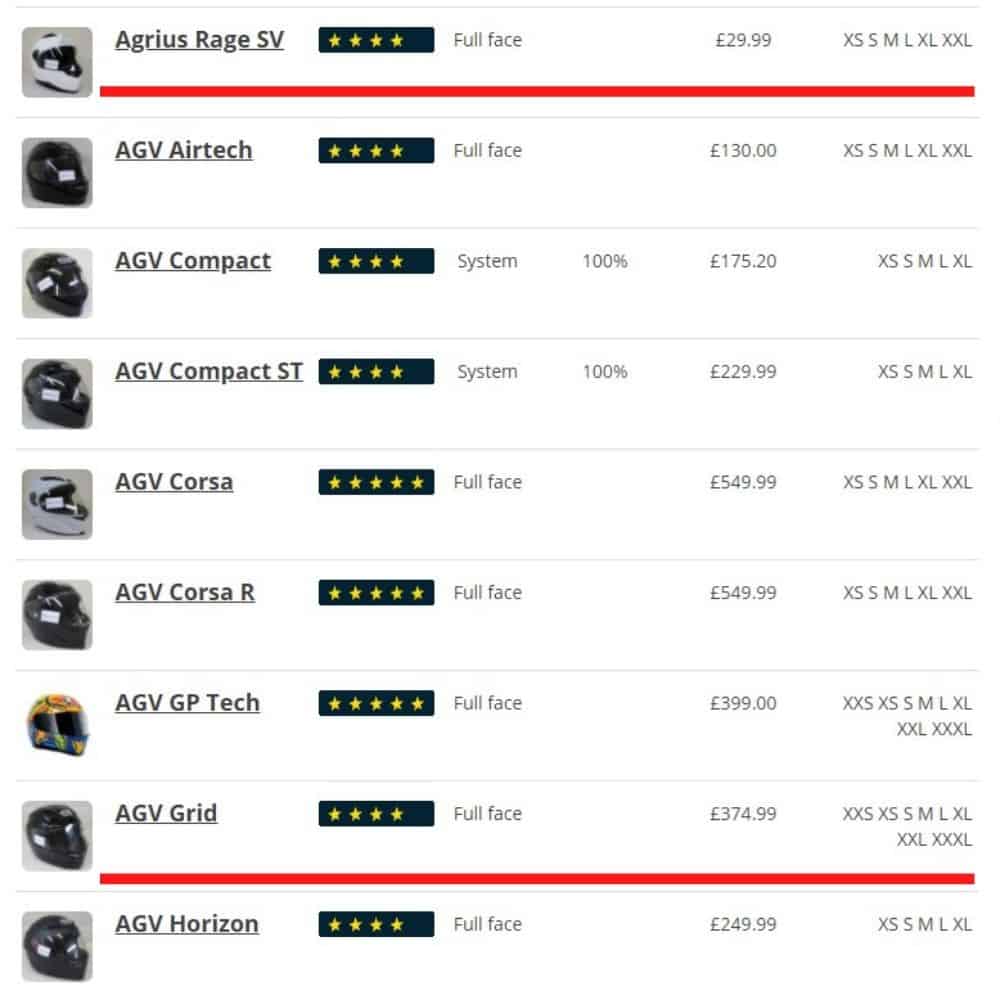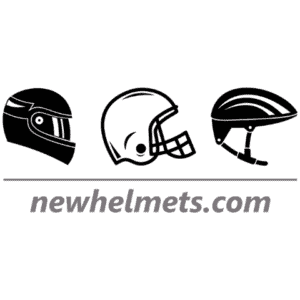Are expensive helmets safer than cheaper models? Looking around online, this is a common question. Are you getting value for money with the higher-end versions? What do you get for that extra investment? Here is the answer.
In many cases, cheap helmets will far exceed the required benchmark set in safety standards such as DOT, SNELL, and ECE. Just because a helmet is expensive does not necessarily make it safer than a more affordable one. Beyond the criteria of the standards, the helmet’s final price is very much dependent on the materials used to make it and the visual aesthetics.
If you purchase a helmet that meets one of the above mandatory safety standards, the legal stance is that you have bought a helmet that is deemed safe to use on the road. All helmets are subjected to the same testing and therefore it is impossible to say which individual model is the safest.
What about professional racing helmets?
In the world of motorsports, their stance is much clearer. Take MotoGP, for instance. They ensure their riders wear top-of-the-line helmets costing thousands of dollars. The reason being there is far too much money on the line; they cannot afford to lose a rider through injury to an inadequate helmet.
Formula One helmets are subjected to additional necessary tests like fire resistance, where the helmet is exposed to a 790 C° flame. They also undertake advanced ballistic testing. All this serves to push the final cost higher.
For average people like you and me, however, things are a little more challenging to explain.
We cannot all be professional racers, so is it sensible to spend massive amounts of money on a helmet? No, it is not necessary to spend thousands of dollars on a helmet, because you will be perfectly safe with a budget option but it’s nice to be able to afford the best money can buy.
To be honest, the way you wear your helmet has a far more significant impact on how safe your helmet truly is. Your helmet must fit correctly for it to function as intended.
Are cheap helmets a waste of money?
If you look at things differently, you might agree that a cheaper helmet is the better option. Take a look at this brilliant YouTube video from Sportbike Track Gear. He gives his opinion on the cheap vs. expensive helmet debate but watch closely, and you will be amazed at the number of helmets he has scratched up.
It sounds counter-intuitive, but if you attend track days, choose a certified cheaper helmet, and if you drop your bike and go sliding down the track, you won’t be so angry that you scratched your budget lid. At the lower price points, you can treat them almost as disposable. I realize no one gets on their bike intending to fall off, but if you do, you will feel a whole lot better knowing you’re keeping yourself safe, but the helmet won’t cost a small fortune to replace.
So, what do the standards tell us?
Short answer, nothing.
We certainly cannot rely on helmet safety standards to help us make an informed decision.
What? I hear you gasp.
Read on, and I will show you what I mean.
The catch with the DOT standard
DOT stands for the Department of Transport, but the official standard is FMVSS 218. (Federal Motor Vehicle Safety Standard) All helmets intended for use on the road must meet this standard in the US. The DOT is a little bit different from Snell, who performs independent testing in house. To achieve DOT certification, helmet manufacturers self-certify their own products. There is no oversight from the NHTSA (National Highway Transport Safety Administration), the organization responsible for enforcing the standard.
Call me cynical, but I would prefer to buy a helmet that has been tested and proven safe independently. However, I might be doing the DOT a disservice here as the NHTSA performs random testing, and if any manufacturer is found to be in breach of the standard, they can be fined up to $5,000 per helmet. Ouch!
You see, it is a pass-fail exercise, and these tests are not designed to separate all helmet models into groups.
Are expensive helmets worth it?
There are no definitive studies to suggest which crash helmet models are safer than others, unlike the NFL, which each year produces an approved helmet list. Please read my article on the safest helmets in the NFL.
However, there is a UK based institution called Sharp, who independently test helmet models and give them a star rating.
Sharp has massively influenced the UK motorcycle helmet market, but the Sharp rating is not a replacement for the traditional standards. The technicians at Sharp subject the helmets to a more rigorous destructive testing and their findings are meant to supplement the ECE standard. For instance, a rating of one-star does not mean the helmet has failed, only that in Sharp’s testing, that model has proven to provide a basic level of protection but is still entirely safe and legal.
Drum roll, please…
Using the Sharp website, we can see that the Agrius Rage SV, which costs £29.99, has the same four-star safety rating as the AGV Grid that costs £374.99.
| Helmet Brand and Model | Sharp Rating | Cost |
| Agrius Rage SV | 4/5 | £29.99 |
| AGV Airtech | 4/5 | £130.00 |
| AGV Compact | 4/5 | £175.20 |
| AGV Compact ST | 4/5 | £229.99 |
| AGV Corsa | 5/5 | £549.99 |
| AGV Corsa R | 5/5 | 549.99 |
| AGV GP Tech | 5/5 | £399.00 |
| AGV Grid | 4/5 | 374.99 |
| AGV Horizon | 4/5 | 249.99 |

Visit the Sharp website for more comparisons.
Choosing one over the other is a decision each person will have to make by themselves, and your budget will be a significant factor in making that decision.
Sure, people will argue that a higher-priced helmet will have a better retention system and superior cheek pads. One opinion could be that these additional creature comforts are the things that make a particular helmet the safer option. Still, another rider may deem them unnecessary and take a completely opposing view.
As consumers, all we can do is assess the information and the data that the marketeers shove in our faces.
What does an expensive helmet look like?
We have all heard the saying, you get what you pay for, so what does the extra cash actually get you.
It will buy you a fancy outer shell, better optics, a better cooling system, removable liners, extra padding, etc. However, in my humble opinion, the more significant price tag just means you tend to respect your helmet better.
That may sound contentious, but it is true.
Let me ask you a question. If your helmet cost you an arm and a leg, would you drop it? Probably not.
You would probably maintain your helmet better, increasing its chances of performing as required when it truly matters.
I realize that this may not be the answer you are looking for, but to be honest, unless you are in a race team, it is hard to prove if expensive helmets outperform the more affordable models.
So, if all money buys you is comfort, and the ability to take care of your helmet better, is it worth it? Probably.
How to ensure you are buying the safest helmet possible
Of course, as we have established, you will never honestly know if your helmet is the safest in the world, but here is a list of some qualities and features that the best helmets are likely to have.
- Hands down, the safest helmet type is a full-faced model with visor. Statistics show that most impacts happen around the chin area, so a helmet with a chin bar is vital. Also, a full-face helmet protects against stones and debris while riding.
- Ensure the helmet has a shell-built design. The outer shell should be made from carbon fiber, and the inner liner should be expanded polystyrene and polypropylene “EPS” foam.
- Removable liner so that you can clean and maintain it better.
- Double D retention system with Kevlar straps
- Anti-fog and scratch-resistant visor
- Decent ventilation system
- Finally, it must pass ECE, DOT, or Snell.
Too cheap to be good
Looking around online there are lots of cheap motorcycle helmets. Many of them are too cheap to be any good, too cheap to be real. You must be very careful when buying motorcycle gear online. A little research will tell you very quickly whether a product is real or fake.
Check out this interesting YouTube video to see the guys at FortaMoto testing cheap, fake helmets bought on Wish and Alibaba. They look the part as they have decals and color schemes to make them look like genuine products. However, it soon becomes apparent that they are very unsafe. The results are eye-opening.
In conclusion. A cheap real helmet from a trusted brand bought from a licensed dealer is well worth the money but go and splash the cash if you have it.
If this is your first visit to my blog, welcome and I hope you have enjoyed it. I discuss all aspects of owning or buying new helmets. From crash helmets to the humble hard hat, this blog has the answers. I talk about the best brands, safety ratings, value, and maintenance. Please, choose another article if you would like to know more.
My name is Matt, and I am a helmet sports enthusiast. I love climbing, motorcycling, kayaking, amongst other things. But no matter what sport you love, please stay safe.


